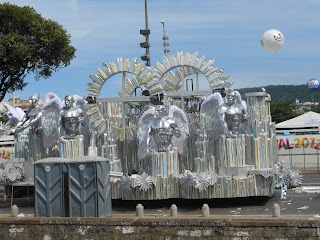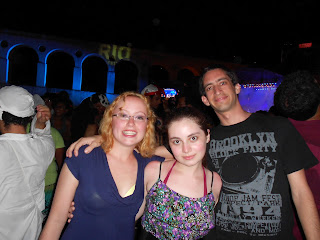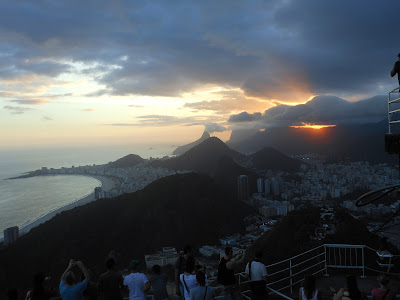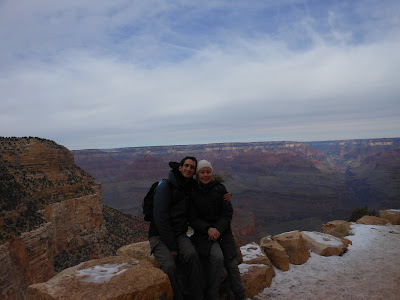For those of you who are not familiar with it, Carnival is basically an enormous, week-long party. It officially occurs on the Friday-Tues proceeding Ash Wednesday (although festivities often begin up to a month earlier), and is celebrated in many Catholic countries, and with particular fervor in Brazil. In Rio de Janeiro, the height of the Carnival festivities is this absolutely fabulous parade of hundreds upon hundreds of samba dancers in incredibly elaborate costumes on enormous glittery floats, dancing to a percussion and brass band.
 |
| One of the Carnaval parade floats |
Unfortunately, the ticket prices were out of our budget so we didn't get to watch the parade from the Sambadrome firsthand, but we did catch quite a bit of it on TV, and we did get to see the floats up close. The floats are constructed on a main thoroughfare (closed to traffic during the holiday, of course) outside the Sambadrome, and on Sunday afternoon we went down to watch the floats being constructed. Here are some of our pictures of the floats up close:
Another great way that Carnival is celebrated in Rio is with blocos, a sort of street party. A group of people arrange a place and a time and pretty much throw a free public party. There is usually what I call a party truck, a huge double decker bus with a live brass and/or percussion band and enormous speakers, and a everyone in the neighborhood (or on the way to the beach or the supermarket) surrounds the truck and dances, sings, drinks, and has a generally good time. We went to a whole bunch of those. Staying in Copacabana made not finding a bloco every day much harder than the alternative.
Perhaps the largest party every night took place downtown (Centro), near the Arcos da Lapa. Lapa was packed to the gills with people partying- to the point of insanity. We visited once with some Brazilian friends we made coincidentally and while it was a lot of fun, it was a little intense for our group.
 |
| Partying at the Arcos da Lapa |
 |
| Where's Waldo? |
 |
| Concert at Centro |
In many ways, Carnaval is sort of a mix between Purim, Halloween, and New Year's Eve, only hotter, with more sequins and Capirinhas. People wear all sorts of crazy costumes.
Some also had hilarious misspelled Hebrew tattoos, although we figured that might not be exclusively Carnaval related, so decided against pointing it out to our unfortunately tattooed friend here.
Some of them even dressed up their dogs.
One of the things I thought was most noticeable, and perhaps surprising about the festivities was that everyone took part in the party, including the very young, the very old, and even the disabled. Additionally, although there was quite a bit of drinking in the merrymaking (particularly in the younger crowds, like in Lapa), there were very few incidents of clear over-indulgence that I saw (or smelled) during or after the revelries. Compared to New York on New Years morning, the streets were positively vomit-free. Of course, we had already discovered that although the beer on tap (chopp) flows like water here, it mostly tastes of water too, so perhaps this contributed to it.
We also tried to go to the beach on one of the days of Carnaval. Bad idea - or very good idea, seeing how everyone else apparently had it too.
 |
| Those are people, not locust |












































